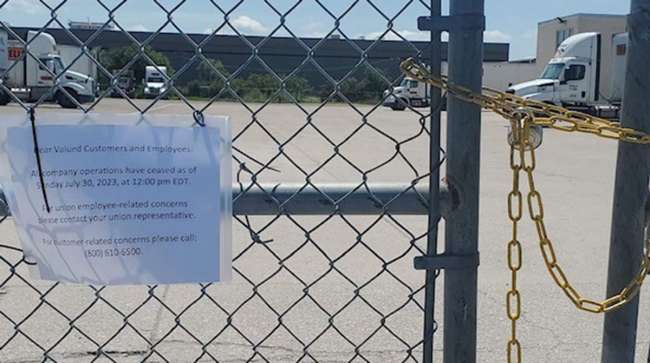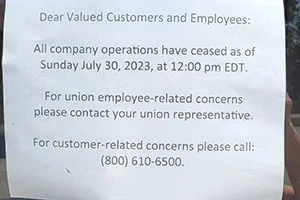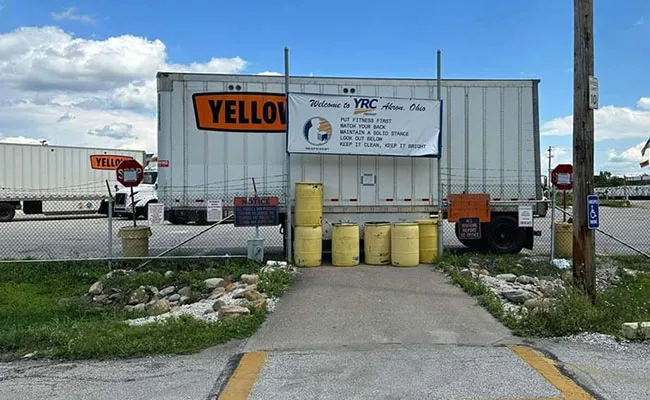Senior Reporter
Yellow Ceases Operations

[Stay on top of transportation news: Get TTNews in your inbox.]
Less-than-truckload company Yellow Corp. on July 30 shut down operations, ending a nearly 100-year history as one of the nation’s largest carriers, and the company began posting notices at terminals.
“Dear Valued Customers and Employees,” the statement said. “All company operations have ceased as of Sunday July 30, 2023 at 12:00 pm EDT.”
The statement instructed union employees to contact their representative with the Teamsters union. The union in a July 30 statement said it had received legal notice that Yellow was ceasing operations and filing for bankruptcy.
Two company executives who spoke to Transport Topics before they were both laid off July 28 confirmed the terminations and the likely end of the carrier.

A termination-of-operations notice to employees and customers posted on a Yellow facility in Carlisle, Pa. (Obtained by Transport Topics)
Yellow ranks No. 13 on the Transport Topics Top 100 list of the largest for-hire carriers in North America.
“Unfortunately, we are done,” said one company executive.
Another executive told TT, “We’re shutting down, and I’ve lost my job.”
Meanwhile, drivers are reporting that terminals and other properties owned by the company are being padlocked and closed.
For the past month, Yellow has been in a deeply precarious financial condition, with the likelihood the carrier will be forced to file for federal bankruptcy protection and the possible liquidation of the company.

Miller
“Yellow ended up shutting down ultimately, because they have had a catastrophic loss of volume over the past few weeks as shippers, concerned about a possible Teamsters strike and whether or not the company was going to be able to make its financial obligations, began diverting their freight to other LTL carriers,” Michigan State University business professor Jason Miller told TT.
The company said last week it was shopping its Yellow Logistics to raise cash.
On July 28, the company began notifying some of the 22,000 Teamsters employees and 8,000 management and nonrepresented employees they are losing their jobs immediately. The union informed workers at several terminals they need to remove personal items immediately from work facilities because those sites could soon be padlocked.
“We recommend that all Yellow employees who have personal belongings and tools at terminals should take them home today,” Teamsters National Freight Industry Negotiating Committee co-Chair John Murphy wrote July 28 in a document obtained by TT.
In a July 10 liquidity disclosure to the Securities and Exchange Commission, Yellow said it had about $100 million in cash as of the end of June.
Miller and others say Yellow’s financial situation worsened, in part because the company is saddled with at least $1.5 billion in debt, including $730 million owed to the federal government.
According to a Treasury Department report, Yellow has paid approximately $66 million in interest but just $230 of the principal owed on the loan, which comes due next year.

The Yellow facility in Hebron, Ohio, bears a sign with tips for drivers on fitness. (Photo obtained by Transport Topics)
The company got a controversial federal loan package written by the Trump administration during the COVID-19 pandemic, when the White House declared the company an essential business and Yellow spent the cash to buy hundreds of new tractors and trailers to upgrade its fleet. The Teamsters, at the time, hailed it as a job-saving measure.
As part of the deal, the federal government assumed a 30% equity stake in the company.
Yellow has about a 10% market share of the LTL marketplace, and it carries a substantial amount of freight for the Department of Defense and the government’s General Services Administration.
Earlier this month, Yellow agreed to pay a $50 million health care payment reimbursement in August to the Central States Pension Fund. The company went along with the arrangement to avoid an almost certain strike by the Teamsters, whose members said they would not work if they did not have health insurance.
Analysts with financial services firm Stephens wrote recently that Yellow is burning through as much as $10 million a day in cash and was hemorrhaging business in the LTL sector. They said the threat of a strike left Yellow “mortally wounded” and the company was near the “end of the road.”
Yellow’s competitors see an opening for new business.
Fort Smith, Ark.-based ArcBest, the parent company of rival ABF Freight, reported in its last earnings call that it has seen an increase of more than 10% in freight, largely because shippers are moving their business to them.

McReynolds
ArcBest ranks No. 12 on the for-hire TT100.
“It is evolving daily, what we are experiencing,” ArcBest CEO Judy McReynolds said. “We can handle that good business and make sure it is working well within the network.”
Even before this latest crisis, Michigan State’s Miller points to Yellow’s financial statements dating to 2014 as evidence the company has been losing LTL market share for the past 10 years.
The company said in a 2014 financial report it was handling 58,280 tons of freight per workday across its network in 2013. But by 2022, the figure had dropped by 47.8% to 30,460.
In its first-quarter financial report, which was published three months before the possible union walkout, Yellow said it had a 12% year-over-year drop in LTL tonnage to 27,430 tons per day and the company’s operating ratio increased to 100.8 from 99.3.
Operating ratio measures a company’s expenses as a percentage of revenue and determines efficiency. The lower the ratio, the greater the company’s ability to make a profit. An operating ratio that’s more than 100 means the company is not generating enough revenue to cover operating expenses and have sufficient money to service its debt or provide a return to shareholders.
In the first quarter, Yellow saw its revenue decline by nearly 8% year-over-year and income dropped and the company posted a quarterly loss of $54.6 million, compared to a loss of $27.5 million in the same period of 2022.
Meanwhile, American Trucking Associations says it has created a website to assist the 30,000 former Yellow employees with finding new jobs in the trucking industry and keeping their careers moving.
Yellow’s closure is a substantial blow to America’s economy and the company’s 30,000 hardworking employees and their families in all 50 states. pic.twitter.com/IHNqszN7iI — American Trucking (@TRUCKINGdotORG) August 1, 2023
"Our message to former Yellow employees is that we want them to remain a part of the industry that they have done so much to build and strengthen. That is why the ATA is launching a new portal to connect former employees with prospective employers who are eager to utilize their unique and in-demand skills and experience,” ATA President Chris Spear said.
ATA said providing this information is completely voluntary and it will be shared only with ATA members and not with third-party vendors.
Want more news? Listen to today's daily briefing below or go here for more info:




